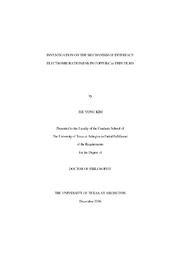
ATTENTION: The works hosted here are being migrated to a new repository that will consolidate resources, improve discoverability, and better show UTA's research impact on the global community. We will update authors as the migration progresses. Please see MavMatrix for more information.
Show simple item record
| dc.contributor.author | Kim, Jee Yong | en_US |
| dc.date.accessioned | 2007-08-23T01:56:26Z | |
| dc.date.available | 2007-08-23T01:56:26Z | |
| dc.date.issued | 2007-08-23T01:56:26Z | |
| dc.date.submitted | December 2006 | en_US |
| dc.identifier.other | DISS-1594 | en_US |
| dc.identifier.uri | http://hdl.handle.net/10106/299 | |
| dc.description.abstract | This study concerns the mechanism of the interface electromigration (EM) in copper (Cu) thin films. While EM in Cu is one of the most concerned reliability failure phenomena in Cu interconnects used microelectronic devices, its mechanism is not well understood yet. In order for better understanding of the EM mechanism, this study attempt to investigate the interface EM mechanism by examining the passivation effects on Cu EM using a cross-strip structure where Cu lines are cross-stripped with different passivation layers. From the observation of the marker polarity (hillocks and voids), the interface EM mechanism is determined whether the passivation layer increases or decreases the interface EM of Cu.
A series of investigation finds that the surface/interface EM mechanism of Cu is different depending on both the passivation material and the thickness of passivation. Differing passivation materials and their thickness do induce change in the kinetics of the marker formation. In all cases, the results show that the mass transport along the metal passivation/Cu interfaces has slower EM rate than dielectric passivation/Cu interfaces. CoWP passivation provides interface with the slowest interface EM, and TaN passivation provides more stable interface with slower EM rate than Ta. In addition, Si3N4 passivation seems to provide interface with slower interface EM than SiO2. On the other hand, when interface EM is compared to surface EM, it is found that the interface EM tends to be faster than the surface EM. This is somewhat unexpected result, but all systems inspected produced a consistent indication. It is found that the reason for higher rate of interface EM than the surface EM may be related to higher Z* at interface.
The results of this investigation may bear importance both for scientific and engineering aspects. This is the first study that shows direct evidence for active interface EM in Cu. While the interface EM and also surface EM needs further investigation in order to understand how they occur, especially the mechanism, the results suggest that engineering the interface may be critical for reliability improvement of Cu interconnects. | en_US |
| dc.description.sponsorship | Kim, Choong-Un | en_US |
| dc.language.iso | EN | en_US |
| dc.publisher | Materials Science & Engineering | en_US |
| dc.title | Investigation On The Mechanism Of Interface Electromigration (EM) In Copper (Cu) Thin Films | en_US |
| dc.type | D.Eng. | en_US |
| dc.contributor.committeeChair | Kim, Choong-Un | en_US |
| dc.degree.department | Materials Science & Engineering | en_US |
| dc.degree.discipline | Materials Science & Engineering | en_US |
| dc.degree.grantor | University of Texas at Arlington | en_US |
| dc.degree.level | doctoral | en_US |
| dc.degree.name | D.Eng. | en_US |
Files in this item
- Name:
- umi-uta-1594.pdf
- Size:
- 3.344Mb
- Format:
- PDF
This item appears in the following Collection(s)
Show simple item record


